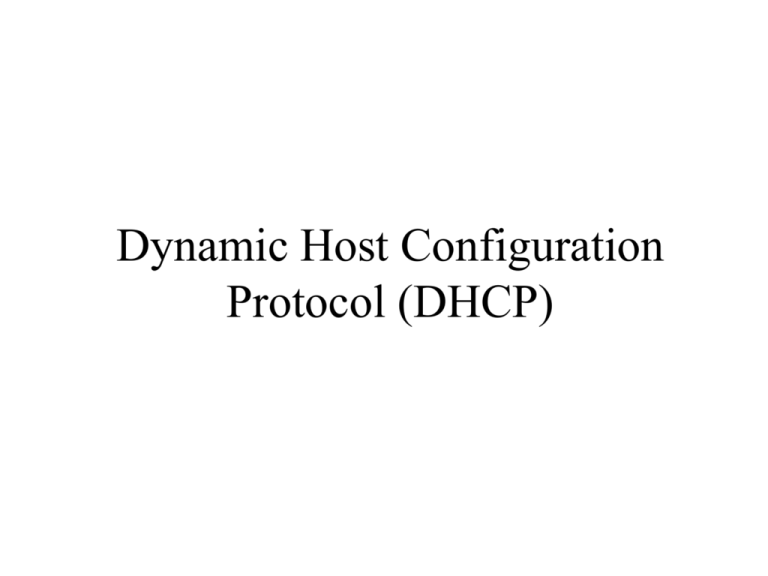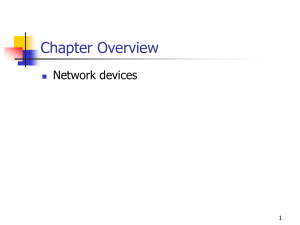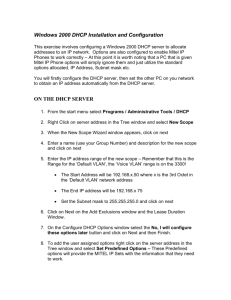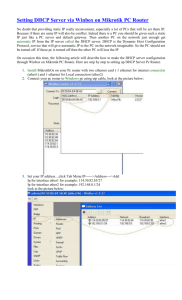options
advertisement

Dynamic Host Configuration Protocol (DHCP) History • Diskless workstations – needed to know configuration parameters like IP address, netmask, gateway address etc. on boot – Small boot programs on ROM needed to load OS over network (bootstrap), need to know boot file server – Knows only its h/w address on boot • RARP (Reverse ARP) can provide some parameters, but complex • BOOTP (BootstrapProtocol) designed to provide these, and some more • Main problem with BOOTP – no dynamic IP allocation DHCP • Extension of BOOTP – allows dynamic IP allocation • Similar message format as BOOTP – DHCP server compatible with BOOTP clients • Can give a wide range of configuration parameters to hosts – IP address, netmask, router, DNS server, boot file server, boot file name, time server, domain name, host name, SMTP server, POP3 server, default IP TTL etc. (see RFC 2132) • Server on UDP port 67, client on UDP port 68 (not ephemeral) • RFC 2131 Motivation • • • • Move a m/c between networks Add a new m/c Reclaim unused IP address space Configuration of the m/c should be simple and automatic IP Address Allocation • Automatic Allocation – Permanent address given to host by DHCP, never expires • Dynamic Allocation – IP address given to host for specific time (lease) – Client host can relinquish before that time or renew after that time – Most common allocation method • Manual – Allocated by administrator (specified in a file) – DHCP only conveys that information to host Basic Operation • Client sends DHCPDISCOVER to DHCP server • Server replies with DHCPOFFER with offer of parameters • If client accepts, client sends DHCPREQUEST to server • Server commits the offer to storage, sends DHCPACK. If any problem, don’t commit and send DHCPNACK, client starts again • Client checks again. If accept, do nothing. If problems, send DHCPDECLINE to server • Client can release parameters before lease time expiry by DHCPRELEASE Basic Operation – Address Allocation • Client broadcasts DHCPDISCOVER message on local subnet – – – – – – Use 255.255.255.255 as destination IP Source IP set to 0 Client’s h/w id sent in message for identification Client can request a specific IP and specific lease time Client can specify a preferred DHCP server Clients can specify what parameters are desired (may not want all parameters that the server can give) • All DHCP servers, on receiving the DHCPDISCOVER – Allocates IP for client • Allocate IP requested by client if possible • Dynamically allocate an IP from pool of available IPs – Lease time set to whatever client has requested (subject to local policy) or default – Selects parameters requested by client, or default set if no specific request – Send a DHCPOFER message to client. This is an offer, not a final commitment. – Message either unicast to h/w address of client or broadcast. Client should specify broadcast (through a flag bit) in any message to server if it cannot handle unicast before TCP/IP configuration • Client, on receiving DHCPOFFER – Can receive offer from multiple servers – Select one server, accept its offer, and send a DHCPREQUEST to it with the configuration parameters – Request is broadcast, but a special server identifier field filled with the server chosen, so that other servers know they are being declines – Timeout to start rediscovery if no offer within a certain time – DHCPREQUEST also sent on boot to confirm earlier allocation, or to renew earlier lease • Server, on receiving DHCPREQUEST – If offer is still valid, commit offer to persistent storage and send DHCPACK to client with the configuration parameters (same as in offer) – If unable to satisfy request now, send DHCPNAK – Makes earlier offered address available for others if timeout for request • Client on receiving DHCPACK/NAK – If NAK, start entire process again – If ACK, make final check (for ex., is IP in use?). If no problem, do nothing. If problem, send DHCPDECLINE – Send request again if timeout for ACK/NAK, give up after few tries • Client can release an IP before its lease expiry by DHCPRELEASE message • If client has already got IP externally (ex. static IP), but wants other config parameters, should use DHCPINFORM message DHCP Message Format • • • • • • • • • • • • • • operation: 1 = request, 2 = reply htype: hardware type (ethernet etc., integer code for defined types) hlen: length of h/w address xid: transaction id used to match request and reply secs: time since client begun address acquisition/renewal flags: top bit indicates if client wants Broadcast from server or not ciaddr: Client IP address. Filled in by client in some cases when client knows its IP yiaddr: IP address of client, Filled in by server after allocation/renewal siaddr: server that responded, filled up by server giaddr: IP of relay agent, if any. 0 indicates no relay chaddr: client h/w address sname: optional DHCP server name to contact file: boot file name options: other configuration parameters Some Examples of *addr fields • DHCPDISCOVER – ciaddr = 0 (no IP known) – yiaddr – irrelevant, to be filled by server – siaddr – irrelevant, to be filled by server – giaddr = 0 – chaddr = client h/w address • DHCPOFFER – Ciaddr – irrelevant (not filled by server) – Yiaddr = offered IP address – Siaddr = IP address of next server to service request – Giaddr = 0 – Chaddr: irrelevant (not filled by server) • DHCPREQUEST – ciaddr = 0 if first allocation, IP address of client if renewing lease – yiaddr = IP address received in offer – siaddr – irrelevant – giaddr = 0 – chaddr = client h/w address • Important point – If ciaddr field is filled in, client must be ready to accept packets to that IP and reply to ARP requests for that IP Options • specifies additional configuration parameters • First 4 octets are special – contains decimal 99, 130, 83, 99 (magic cookie) • Variable length list of options after that, always ends with a special option “end” • Format of each option – TLV encoded – 1 octet type code (interger code for each option) – 1 octet length – Multioctet value of specified length Example Options • Message type – type of message (discover, request, offer etc.) • Client identifier – an explicit identifier specified by the client. Client must use the same identifier in all subsequent messages • Requested IP address – set by client to request a specific IP • Maximum DHCP message size – set by client to indicate maximum size of message acceptable to it • Parameter request list – list of config parameters requested by client • Server identifier – server selected by client among multiple offers, sent in DHCPREQUEST • See RFC 2132 for a list of options • New options can be added through central authority (see RFC 2939) Persistent Storage in DHCP • Once an allocation is committed, it needs to be stored to make it persistent – Needs unique id for a client – Needs unique id for a lease • Client id – If client supplied an explicit id in client identifier option, use it – Else, (IP subnet number, h/w address specified in chadr field) – This implies host with multiple interfaces must do a separate DHCP discover etc. for each interface • Lease id – Needed to identify a lease for renewal etc. – Id for lease = (client’s id, assigned network address) • DHCP tries to assign the same address to a client everytime it requests, before or after lease expiry – Looks up last lease of client if there in storage, if address is unallocated, assign that – Overridden by “requested IP address” option if set by client BOOTP/DHCP Relay • At least one DHCP server per subnet may be too costly if no. of subnets is large • Relay agents: special processing for packets to UDP port 67 • giaddr field: 0 indicates client-server on same subnet, no relay. If not, field specifies IP address of relay agent – Set to 0 by client. First relay agent that picks up the DHCP packet from client puts its IP in that field, not changed by subsequent relays • Any message from server to client sent to relay agent’s DHCP server port if giaddr is non-zero • See BOOTP Relay part of RFC 1542






